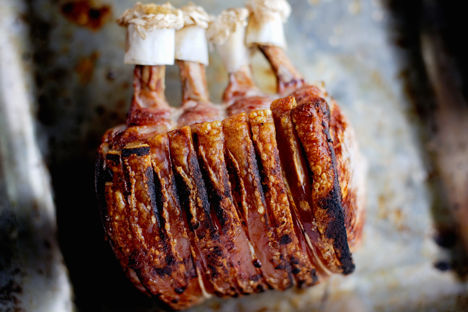The UK has a love affair with pork stretching back centuries, and British pork is admired and eaten the world over. The meat is integral to many of Britain’s national dishes – from Pork pie to Roast pork with apple sauce– but is also used in curries, stews and meatballs.
What to look for when buying pork
When buying cuts of pork, look for a deep-pink colour of meat, not grey or red, with a fine-grained texture. Pork should have a slight marbling of fat throughout the cut, which should look firm and white. Free-range, organic and rare-breed pork such as British Saddleback, Large Black and Tamworth will likely have a deeper pink colour and a healthy amount of fat. Although these rare-breed pigs are slightly more expensive they are generally very well cared for - and often more flavourful as a result.
Fresh pork should be stored in the fridge or freezer. Offal and mince should be eaten on the day of purchase.
How to cook pork
Every part of the pig can be eaten; from nose to tail. The key to cooking pork well is an understanding of which cooking method is appropriate for each cut.
Another important tip to remember when cooking pork is that the meat needs to be seasoned well – this doesn’t have to just be with salt and pepper as you could also use herbs, spices or a brine to impart flavour.
Use a meat thermometer to check that the meat is cooked - pork needs to reach at least 63⁰C in the centre to be safe to eat. However, it is more common to see pork cooked all the way through, but still moist.
Like most meats, pork should be allowed to come up to room temperature before cooking and left to rest for a period after cooking.
The most common cuts of pork for slow cooking include leg, shoulder, cheek and belly. Offal cuts such as trotters and ears can also be slow cooked. These cuts of meat have a higher fat content and are tougher; so a lengthy cooking method will help tenderise them.
Pot roasting, stewing and braising are all good methods for cooking these cuts of pork, just make sure the meat is basted at regular intervals to avoid it drying out.
The tender, less exercised cuts of pork are better suited to cooking quickly – either in a pan on the stove or in the oven. Overcooked pork is dry and tough, so make sure to keep an eye on it as it cooks.
The cuts of pork most suited to rapid cooking include loin and fillet or tenderloin as it is sometimes known. Often these cuts are marinated first to impart flavour.
What goes with pork
Pork is a rich, fatty meat which, delicious though it is, can cloy if not counter-balanced with sharper tasting ingredients. The obvious pairing is apple, which is well known for flattering the umami quality of the meat.
Honey also combines nicely with pork. Its mellow sweetness can be used to marinate the meat before cooking, as demonstrated by Josh Eggleton.
Seafood and pork is a surprisingly good combination; chefs Robert Thompson and Matthew Tomkinson have created dishes which feature both.
Get in touch
Please sign in or register to send a comment to Great British Chefs.



